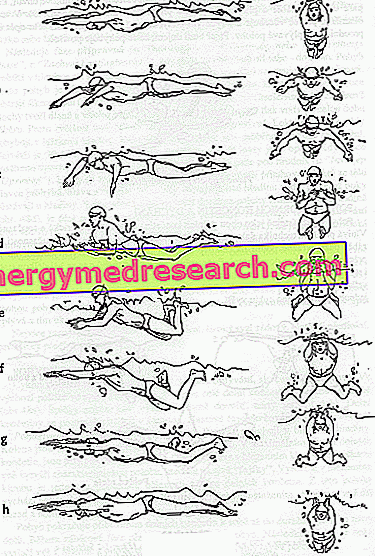Generality
The burger is a type of sandwich consisting of a soft bun stuffed with a discoid meatball based on minced meat and grilled or grilled.

NB . Many of the DA FAST FOOD burgers (therefore excluding home-made, vegetarian, or any other "healthy" variant) are among the junk or junk food.
In short: etymology of the term "hamburger"
Although the hamburger is a food born in America (USA - 1900 AD, by the Danish Louiss Lassen) * and then spread all over the world, the etymology of the term suggests a clearly central European derivation. "Burger" comes from "Burg" (fortress - makes up the name of many German and Austrian cities) or Amburg (German city); therefore, hamburger is a modification of the term burger, in turn an indicator of "origin" from Hamburg, or German or Austrian "nationality".
Meatball burger - Hamburger
Hamburger meatball is the symbol of American food. It comes from the union between the ground of lean beef (originally from the western pastures) with the fat obtained from the processing of the fattest cattle (originally from the eastern pastures). As it is easily deducible, the hamburger represents a valid strategy to allow the disposal of many butcher waste "cuttings" otherwise destined for waste. This is a more than correct ethical-professional principle (since nothing would be discarded from the slaughtered animal, partly due to moral integrity, a little due to respect for natural resources), BUT PURTROPPO among the hamburger ingredients stand out high quantities of adipose tissue, which dramatically increases the intake of saturated fat and cholesterol. The hamburger is therefore a highly contraindicated product for the CONSUETUDINARIA COLLECTIVE diet and in particular for that (also occasional) of the overweight subjects and / or suffering from metabolic pathologies (above all hypercholesterolemia).
Hamburger sandwich
The hamburger sandwich, as a consequence, is born on the same territories; today it is prepared with many different recipes and the variations between the various sandwiches concern:
- The choice of ingredients for bread (flours, fats, ornamental cereals, etc.)
- The choice of ingredients for the formulation of meatballs (meat, pork, avian, horse, sheep, fish, soy protein, wheat protein, etc.)
- The choice of additional seasonings: sauces (ketchup, mustard, mayonnaise, Tabasco etc.), cooked and raw vegetables (lettuce, grilled eggplant, grilled onion, grilled zucchini, sliced tomato, fried potatoes, etc.), preserved vegetables (gherkins) pickled, pickled vegetables etc.), preserved meats (bacon), eggs (scrambled, fried, sliced boiled eggs etc.).
Dietary burger problems
It is now a unanimous opinion that the fast-food burger is a product from which it would be better to "stay away!" ... well, in the vast majority of cases, this common place certainly corresponds to the truth. The reasons behind these claims are many and quite clear.
First, let's focus on the nutritional composition of the hamburger. Citing the simple one (without cheeses or sauces, to "not rage"), a chemical analysis of its ingredients highlights two negative aspects to say the least:
- Excessive heat
- High concentration of hypercholesterolemic molecules.
The energy density of the hamburger is therefore excessive; this is due to the presence of a considerable lipid portion contained in the ground meat which, combined with the proteins of the same and the carbohydrates contained in the white flour of the bread, make the hamburger a food that is difficult to contextualize in any diet that does not belong to a suer-sportsman . Furthermore, we remind you that there are GIANT hamburgers but, in parallel, it is not easy to find smaller ones, which is why it should NOT be consumed by the very young, by sedentary people and by subjects with obvious excess weight.
It's not all; the hamburger is made up exclusively of pre-processed raw materials. Starting from the bread of white flour (soft, sweet and without crust), to get to the ground meat (very tender because it is supplemented with adipose fat), this sandwich has two other major drawbacks:
- Deficiency in dietary fiber, vitamins (especially carotenoids, tocopherols, ascorbic acid, calciferol, folate, etc.) and mineral salts (potassium, magnesium, calcium, etc.);
- Excessive propensity for meal transience.
The lack of some nutrients often results in the incompleteness and nutritional imbalance of the meal (often supplemented with fried potatoes, which are also lacking in the molecules mentioned above), while the ease of chewing causes an unnatural celerity in consuming a noticeable contribution caloric (which using other raw materials would require GREATer chewing, commitment and consumption times). Needless to say, swallowing a hamburger quickly does not allow the digestive tract the time necessary to send the satiety signals to the central nervous system, which, for its part, has previously estimated the sandwich as an insufficient meal due to its small size.
It should also be considered that the hamburger has considerable health and hygiene complications; minced meat is characterized by a very large area of bacterial proliferation. For this reason, in the USA, at the industrial level, meatballs are compulsorily marketed in frozen form; however, this does not mean that there are often food poisonings caused by the ingestion of unhealthy burgers (in particular due to the infection with Escherichia coli O157: H7 ). This is attributable both to the poor storage of the food and to the insufficient cooking of the same (which sometimes does not reach 80 ° C at the heart of the meatball). Not least the wide concentration of toxic molecules due to the carbonization of fats and proteins in cooking; these are polycyclic aromatic hydrocarbons, formaldehyde, acrolein, etc., molecules of toxic and / or mutagenic nature, the result of excessive grilling and grilling. The reader will wonder what the difference is between a grilled hamburger in a fast-food restaurant and a grilled chicken breast cooked at home. Simple; food residues present in work equipment (grids, plates, pliers, pallets, etc.); the restaurants prepare dozens or hundreds of hamburgers, which is why the fats and proteins of the various meatballs contribute to raising the presence of these unwanted catabolites exponentially.
Burger sandwich VS full meal
| Food / meal | Total weight (g) | Fibers (g) | Proteins (g) | Fats (g) | Carbohydrates (g) | Energy (kcal) |
| Hamburger of a well-known fast food | 208 | 2 | 25 | 25 | 40 | 495 |
| Complete meal based on dish, side dish and bread | ||||||
| Chicken breast | 150 | - | - | - | - | - |
| Lettuce | 100 | - | - | - | - | |
| Extra virgin olive oil | 10 | - | - | - | - | - |
| Whole grain bread | 50 | - | - | - | - | - |
| TOTAL | 260 | 3.7 | 38.8 | 12.7 | 28.7 | 385.5 |
As can be seen from the table above, the qualitative difference between a complete meal and a hamburger sandwich is considerable. We wanted to mention only a few values and not all, but even looking at only the energy macronutrients it is obvious how much the sandwich in question is disadvantageous. A complete meal that provides up to 110kcal less (about 20%), can weigh over 50g more (about 20%), with a decidedly higher satiating power, a decidedly greater nutritional quality and an exponentially toxic intake of molecules. lower.
Why insist on fast-food burgers? Indeed there is no reason; among other things, in order to satisfy the palate of the most ardent consumers of the famous sandwich, numerous variations of the sandwich have been invented. There are choice meat burgers, vegetable proteins, legumes, etc. In this regard, I suggest the vision of some recipes proposed by Alice on mypersonaltrainerTV :
- classic burgers
- burger with green olives and black olives
- ham and cheese-filled burgers
- vegan rice and soy burgers
- vegan soy meatballs
- lentil burgers
Cordon Bleu Classici
X Problems with video playback? Reload from YouTube Go to Video Page Go to Video Recipes Section Watch the video on youtube



